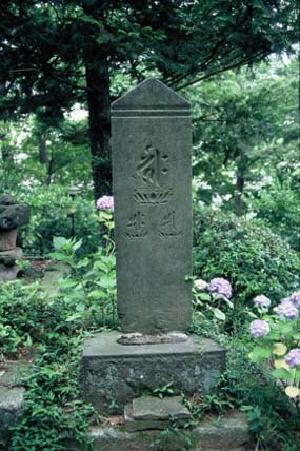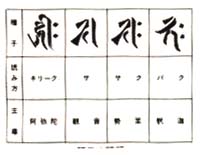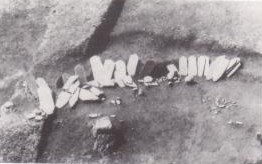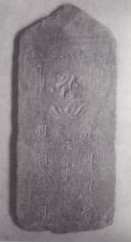Last updated: June 27, 2017

Myokaku-ji temple monument (City-designated cultural property)

Name of each part of the tablet
Itabi are memorial towers built from the Kamakura period to the Azuchi-Momoyama period (13th to 16th century), and are placed all over the country to commemorate the dead and pray for the comfort of future generations. It was built.
Due to the different stones used in each region, some have different shapes, but most have the following shapes. The overall shape is plate-like, and the top is shaped like a triangular mountain. The lower part has two lines and incisions to distinguish it from the main body. The main body is divided into a rectangular shape with seeds, canopies, and lotus stands that represent the Tathagata and Bodhisattvas in Sanskrit characters and images. ), vases, etc. are engraved with patterns such as vases, year inscriptions (kinenmei), and the names of the memorial service recipients.
It is believed that the tablets originated in the central and northern part of Musashi Province, the stronghold of the Kanto samurai. In Saitama Prefecture, there is a tablet dated to the 3rd year of Karoku (1227), which is believed to be the oldest at present, and it is thought that it gradually spread from this region to surrounding areas and eventually became distributed throughout the country. Masu. Nationwide, it turns out that it is made most often in the Kanto region, using chlorite schist (a blue rock that is easy to process) produced in the Chichibu region of Saitama Prefecture. It is called the Musashi-type board monument. The custom of building tablets, which began in the Kamakura period, flourished mainly in Musashi Province, and disappeared at the end of the Middle Ages. In the Edo period, all traces of these graves disappeared, and soon gravestones were erected. For this reason, tablets can be said to be stone structures representative of the Middle Ages.
Currently, 268 board monuments have been confirmed in the city. In addition to being made of chlorite schist, one tablet made of Ina stone has recently been discovered. Most of them are small, about 50 to 60 cm in height. By region, the Daimaru area had the most, with 102, followed by the Yanoguchi area with 44, the Hirao area with 43, the Sakahama area with 30, and the Hyakumura area with 28, followed by Higashi-Naganuma (5) and Oshidate (7). There are not many in both districts. (9 unknown) Their distribution tends to be more common near old villages and roads, on the border between hills and plains, and less in areas on the Tama River flood plain. However, because the board monument is a movable stone structure due to its size, it is necessary to consider the possibility of it being washed away due to flooding of the Tama River or secondary movement.
The oldest tablet in the city was built in 1289, and the newest one was built in 1536. The construction of tablets continued for about 250 years (from the late Kamakura period to the late Muromachi period), but the period from the 1310s to the 1390s can be said to have been somewhat prosperous.
Next, we will introduce some of the distinctive board monuments.
The board monument at Myokakuji Temple in Yanoguchi (photo above) is 112 centimeters above the ground and is the largest, well-preserved board monument in the city. Seed of the Amida Sanzon, the name of the donor engraved with ``Gyakushu Doshu Zenmon'', Kyotoku 3 The year (1454) and other markings are clearly engraved. In addition, it is the only example in the city that has four lines of Sanskrit characters representing Komyo Shingon written on it.
In the southern Kanto region, two unique 13 Buddhist tablet tablets have been discovered. This tablet represents the seeds of the Thirteen Buddhas, and is from the Muromachi period, when the group worshiped the Five Tathagata, the Seven Bodhisattvas, and the Ichimyou. It became popular as a folk belief after that. Another distinctive feature is that the thirteen Buddhas are arranged in a special arrangement that is different from the general arrangement.
The tablet unearthed from the Iridyo mound in Hirao is a rare tablet with gold paint remaining on the letters, and is the name of an Esoteric Buddhism monk named Choshin Hoin who entered the mound. is engraved on it, making it a valuable historical document that shows the reality of the faith.
Other distinctive tablets include Shinto tablets, Jishu-style Amigo tablets, and the six-character name "Namu Amida Butsu". There is a plaque with the name Rokuji Myogo. In addition, as a special excavation, there are three groups of tablet tablets (78 in total) discovered on the slope of the Daimaru ruins, and these are thought to have been collected from other places and rearranged secondarily.

kind of glyph

Group of stone tablets excavated from the Daimaru site

Thirteen Buddha tablet monument (Inagi City storehouse)
Inagi City Education Department Lifelong Learning Division Tel: 042-377-2121